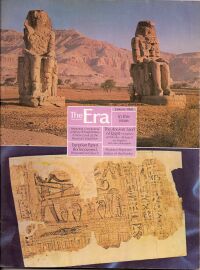
FAIR is a non-profit organization dedicated to providing well-documented answers to criticisms of the doctrine, practice, and history of The Church of Jesus Christ of Latter-day Saints.
(: m) |
mNo edit summary |
||
| Line 39: | Line 39: | ||
|link=Book of Abraham/Joseph Smith Papyri/Text/Size_of_missing_papyrus | |link=Book of Abraham/Joseph Smith Papyri/Text/Size_of_missing_papyrus | ||
|subject=The "Missing Papyrus" theory | |subject=The "Missing Papyrus" theory | ||
|summary=This theory assumes that the Book of Abraham ''was'' on the papyri in Joseph Smith's possession, but the portion recovered from the Metropolitan Museum doesn't include it. This is a possibility because the recovered portion is less than 13% of the total material held by Joseph.{{ | |summary=This theory assumes that the Book of Abraham ''was'' on the papyri in Joseph Smith's possession, but the portion recovered from the Metropolitan Museum doesn't include it. This is a possibility because the recovered portion is less than 13% of the total material held by Joseph.<ref>{{Book:Gee:Guide to the Joseph Smith Papyri|pages=23}} Eyewitnesses also reported that the length of the papyri in Joseph's possession was much more extensive than the fragments now held by the Church.<ref>"In 1906, while visiting Nauvoo, President Joseph F. Smith related to Preston Nibley his experience as a child of seeing his Uncle Joseph in the front rooms of the Mansion House working on the Egyptian manuscripts. According to President Smith, one of the rolls of papyri "when unrolled on the floor extended through two rooms of the Mansion House." This would have been sometime between 1843 when the Mansion House was completed and the prophet's death in June 1844, one or two years after other parts of the papyri had been cut up and placed under glass. - See {{Dialogue1|author=Hugh Nibley|article=Phase I||vol=3|num=2|date=Summer 1968|start=101}} See also {{IE|author=Hugh Nibley|article=New Look at the Pearl of Great Price|vol=71|date=March 1968|start=17|end=18}} and Hugh Nibley, "Judging and Prejudging the Book of Abraham," Nibley archive, 1979, 6-7; reprinted as an appendix in Robert L. and Rosemary Brown, ''They Lie in Wait to Deceive'', vol. 1, ed. Barbara Ellsworth, rev. ed. (Mesa, AZ: Brownsworth, 1982), 236—245.</ref> | ||
}} | }} | ||
{{SummaryItem | {{SummaryItem | ||
| Line 56: | Line 56: | ||
=={{Endnotes label}}== | =={{Endnotes label}}== | ||
{{Articles Footer 1}} {{Articles Footer 2}} {{Articles Footer 3}} {{Articles Footer 4}} {{Articles Footer 5}} {{Articles Footer 6}} {{Articles Footer 7}} {{Articles Footer 8}} {{Articles Footer 9}} {{Articles Footer 10}} | {{Articles Footer 1}} {{Articles Footer 2}} {{Articles Footer 3}} {{Articles Footer 4}} {{Articles Footer 5}} {{Articles Footer 6}} {{Articles Footer 7}} {{Articles Footer 8}} {{Articles Footer 9}} {{Articles Footer 10}} | ||
[[es:El Libro de Abraham/Papiros de José Smith/Texto]] | [[es:El Libro de Abraham/Papiros de José Smith/Texto]] | ||
[[Category:Book of Abraham]] | [[Category:Book of Abraham]] | ||
Contents |
| Answers portal |
| The Book of Abraham |
 |
|
FAQ:
Book of Abraham content: Production: |
|
The text of the Book of Abraham is not present on any of the recovered fragments of papyri.
We do not claim to know why the text of the Book of Abraham (or the missing Book of Joseph) is not in evidence on the fragments of papyrus that were recovered. Critics, of course, simply assume this to be conclusive evidence that Joseph was a fraud.
From a believer's perspective, however, there are several possible theories to account for this:
Summary: We do not claim to know why the text of the Book of Abraham (or the missing Book of Joseph) is not in evidence on the fragments of papyrus that were recovered. Critics, of course, simply assume this to be conclusive evidence that Joseph was a fraud. From a believer's perspective, however, there are several possible theories to account for this: 1) The text was revealed much in the same manner as that of the Book of Mormon, without the need for the actual papyri, 2) The text was present on portions of the papyri that are missing, and 3) The Book of Abraham manuscript was attached to the Book of Breathings manuscript and was lost. 4) Perhaps there was a way of understanding the Egyptian ideograms anciently that is unknown to Egyptology in our day, yet to be discovered, deciphered or acknowledged, that could yield an interpretation of a text that is different than the standard Egyptological reading.
</ref> missing for <ref> tag
<videoflash>76kANp4cxQg</videoflash>
==

FAIR is a non-profit organization dedicated to providing well-documented answers to criticisms of the doctrine, practice, and history of The Church of Jesus Christ of Latter-day Saints.
We are a volunteer organization. We invite you to give back.
Donate Now